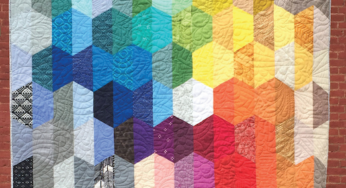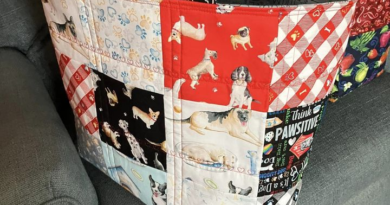Orange Peel Zest Quilt Pattern
Patchwork and quilting are very old crafts. Records of such work date back to 3400 BC. In ancient Egypt, pharaohs already wore clothing made from scraps of fabric to wear under iron armor and quilts. During the Middle Ages, patchwork and quilts were found all over Europe (England, Italy, France, and Germany). Patchwork and quilts were brought to America by British pilgrims fleeing religious persecution. With the invention of the home sewing machine in 1846, patchwork and quilting were made by machine and by hand. After the 2nd. World Wars, women began working outside the home. For a while, patchwork and quilting were forgotten.
In the 1970s, however, with the rise of the hippie movement, crafts were taken seriously again, and quilts and patchwork were reinvigorated. In the modern world, patchwork is made not only with found scraps, but with appropriate fabrics, manufactured and purchased exclusively for this purpose. It is no longer a waste; it is an art. Thus, from being merely utilitarian, patchwork has become ornamental, being exhibited in international fairs with product presentation and well-defined work criteria.
Spiders, Minerva, and Patchwork: Legends. The spider web is a symbol on many antique quilts and, according to legend, represents the ability to “quilt”. There is also a “sympathy”: a spider web was drawn on the back of a girl’s hand to bring her abilities. Spiders, butterflies, bees, and various other insects are always together. In Crazy Quilts, spider webs in particular are not to be missed in the embroidery. In Victorian times, when crazy embroidery was in vogue, spider webs were believed to bring good luck and butterflies were seen as symbols. immortal. During the 18th and early 19th century, bees and spiders and their webs were often used as symbols of the textile industry.

But what about Minerva? She was the protector of Rome and, above all, the defender of craftsmen and manual labor. Legend has it that Minerva was very skilled, but was once challenged by the mortal Arachne, a craftsman known for his embroidery. The challenge involves each person weaving a piece of cloth. Minerva represents in her cloth the battle with Neptune over which name the city of Athena should use. Arachne, as a sign of provocation, represents the intrigue and perversion of the Olympian gods. However, Arachne did this perfectly, and Minerva, despite not liking the expression on this cloth, could not find fault with the work.
Furious Minerva forgot that she was a goddess and tore Aracne’s clothes. The latter was moved to despair, seeing her perfect work torn, and tried to hang herself with rags. Out of pity, Minerva held her in the air so she wouldn’t strangle herself, and said to her, “This will be your punishment and all your descendants. At the same time, Arachne felt her head and body shrink. Small claws replaced her arms and legs, and the rest of her body became a giant belly. Since then, Aracne has been in constant motion. Stop and turn, the human industry yet to match the delicacy of her fabrics. Did you see this? Legends, truths, coincidences, who cares? In fact, what these stories are passionate about is to realize what patchwork really means. It is learning how many stories, how many emotions are involved in this patchwork alliance.
>>>> PATTERN FREE <<<<
SEE TOO : Deb’s Binding Tool Star Quilt



